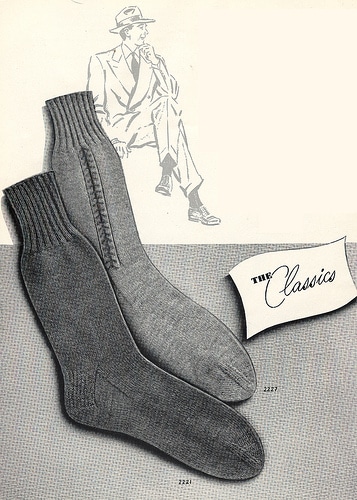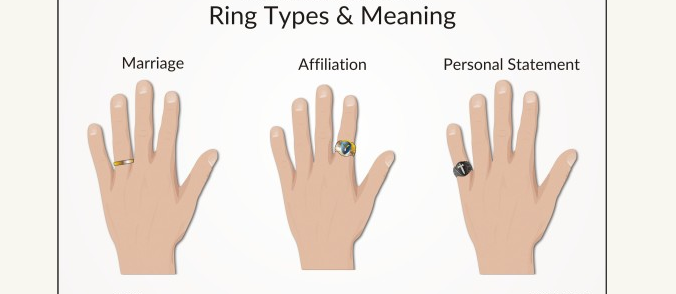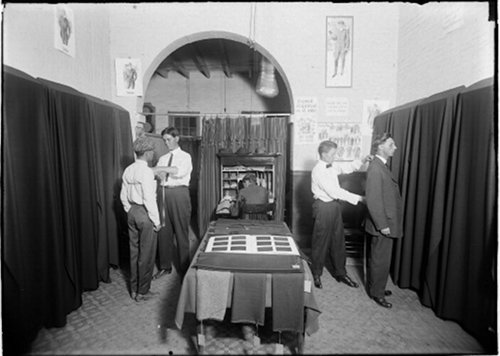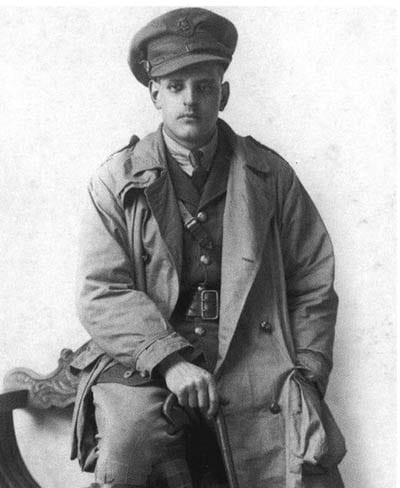I wear my wedding ring on my right hand.
The reason? I married my wife in a Ukrainian Orthodox church and have never felt the need to move it even though we live in a country where 99.99% of people wear it on the left hand.
My ring is a small silver metal band that maybe cost $20. Nothing to brag about. Yet it has been the subject of hundreds of conversations over the last 8 years because of its placement.
That’s the power of jewelry–for better or worse it sends signals about who we are, what commitments we have made, and our status in society.
Step outside the norm and people notice. Depending on your goals, this may be a good thing or a bad thing.
The goal of this article is to help you understand the guidelines to wearing jewelry so you can better control the signals you send. Because these tiny pieces of metal and stone can have a big effect on the opinions of people we’re trying to work with or get to know, you want to make sure you’re sending the right visual message.
Please note – this is one man’s perspective. I am aware that different cultures around the world view the wearing of jewelry differently. I would love it if in the comments below you expand on your view of male jewelry and its role in your environment.

4 Rules for Men When Wearing Jewelry
1. Keep It Simple
When in doubt, keep it simple. Start with a classic leather-strapped silver watch; if you regularly wear a watch and can afford it, consider a sportier diving watch with a stainless steel band as well. Next branch out to tie accessories and cufflinks.
Once you’re comfortable wearing these generally accepted pieces, then you can start to introduce other jewelry pieces like necklaces if you choose. For a quick visual guide, visit Joe’s awesome chart over at Dappered.
2. Match Metals
Most men’s jewelry is metallic. Gold and silver tones are the most common. Your outfits should only feature one metal tone at a time.
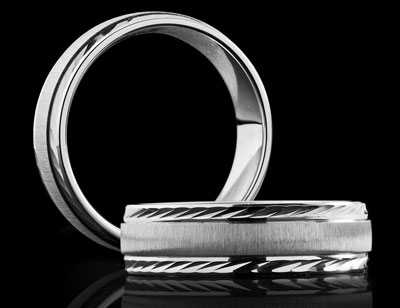
- Gold is a warmer color and reads, predictably, like a yellow accent in terms of the color wheel. It goes well with browns and other earth tones, as well as with deep hues like royal blue or hunter green. Watch for differing tones if you’re buying multiple pieces of gold jewelry–gold comes in a broad range of darkness/lightness, and you may end up with pieces that don’t match if the difference is extreme.
- Silver and silver-tone metals like polished stainless steel or chrome are neutral. They read as grays, functionally outside the color wheel, falling instead on the black-to-white gradient. That means they don’t clash too sharply with anything, but also don’t provide the same eye-catching contrasts that well-worn gold can. Pair silver jewelry with black or dark gray clothing for a sleek, timeless look, or you can wear it with lighter colors in the summer without the fear of it overwhelming your clothing’s soft colors.
- Copper and bronze are orange-hued metals and should be treated as such. They’re bolder than gold or silver and need to be worn with restraint. You’ll see copper-tone jewelry in more casual outfits, and an heirloom copper ring or shirt buttons/rivets can add to a plain trouser and shirt.
- Precious stones need to be kept to a minimum. They’re like purses–no matter how egalitarian you want to get about it, they’re still feminine to most. A single color of stone on a ring or a single colored ear stud is the max. Anything beyond that is either flaunting your wealth in an obnoxious way or just plain gaudy.
- Turquoise gets a little bit of an exception for any man who wears deliberately Western styles. It’s become something of a Southwestern gentleman’s stone. A bit on a ring, bolo tie, or belt buckle goes great with jeans and a collared shirt. Just be aware that it is a bright color and tends to be eye-catching–wear small amounts, and only when you want to draw attention to wherever the stone is located.
- Leather is touchy for anyone who isn’t in high school or a rebel. If you’re going to wear it, make sure it’s in natural earth-tones, not dyed black, and never with ostentatious metal studs. Unless you ride a motorcycle, and even then, only when you’re actually riding the motorcycle.
- Wood and bone are starting to show up more and more in men’s jewelry, often in reference to various ethnic traditions. They’re usually on the paler end of the earth tones–take them case by case, and just be sure that you’re not wearing the jewelry right up against something that’s similar in color but not an exact match. If you’re going to wear an unusual material like that, it needs to stand out a bit to really work.
The exception to issues of color matching are wedding bands and heirloom pieces. A man can always wear his wedding band; if it doesn’t go with your other metal pieces, don’t sweat it. It’ll just draw a bit of attention, and there’s nothing wrong with having people notice the visible symbol of your commitment. As for heirloom pieces, try to match but assuming the piece is non-attention grabbing (such as a small ring or watch), the clash of metals is acceptable.
If you’re going to be buying jewelry soon–make sure to first read my primer here on buying male jewelry where I explain metal and stone details in further depth.

3. Understand Jewelry’s Symbolism
Jewelry has meaning.
You can’t get away from this. Despite it taking up only a tiny percent of your visual presentation, people zero in on jewelry thanks to its flash and uncommon usage by men.
To further complicate the matter, people can interpret the meaning of the same piece of jewelry very differently. To some, ornamental rings symbolize success and wealth; to others they signal organized crime affiliation.
That means a man has to be careful when wearing jewelry pieces outside the norm. It’s easy to appear flashy when you start including nondescript jewelry in your daily getup. However, jewelry can add a helpful bit of color and uniqueness to an outfit. So how does a well-dressed man balance it?
- Avoid Ostentatious Styles. It’s hard to repeat this point often enough. Keep anything metallic small and sleek.
- Wear Meaningful Jewelry. We’ve talked about wedding rings already. Other accents that have meaning might include a class ring, a fraternal insignia, a military service pin, or an athletic ring or necklace. These can be “door openers and conversation starters;” if you’re talking to prospective business partners in Houston, it makes sense to wear your A&M class ring if you know they went to school in College Station. If you’re interviewing artists for a gallery show in New York, perhaps heirloom cufflinks your uncle made can help display you care about art because you come from a family of artisans. Choose jewelry that’s going to be meaningful within the situation.
- Know When to Wear It. Save your best for the big occasions in life. Personally I rarely wear any jewelry–despite being in the clothing industry I prefer simple pieces. But when I have an important event to attend, I pull out my watch and cufflinks. Bringing specific pieces out for specific events–instead of everyday wear–makes them less status pieces and more festive statements.
4. Jewelry and Dress Codes
In the business world, company dress codes can severely restrict male jewelry. Often phrased in a politically correct tone such as, “Men should only wear tasteful pieces of jewelry,” you’ll find in practice that this means not rocking the boat and conforming to the status quo. So if you’re hired at AT&T corporate, be careful about trying to wear as many necklaces as Mr. T.
Seriously–the burden of appropriateness is always on the man who chooses to wear jewelry. Know this and be restrained when you’re in any kind of professional setting. You can express yourself after work. Jewelry is, by its nature, small enough to slip into a jacket pocket after all.
Businesses that request “modest” or “tasteful” or “appropriate” jewelry, or other words along those lines, prefer things be limited to the traditional “masculine” styles of jewelry. This includes tie accents, watches, cuff-links, wedding bands, and lapel pins. Over the last decade most companies have expanded this to include bracelets, earrings, and ethnic jewelry as well.
Piercings (other than earrings) are dicey even in casual outfits. If your office and social circles are comfortable with nose or lip piercings, that’s great, but it’s still going to seem off-putting to some strangers that you interact with–clerks at stores, taxi drivers, what have you.
Unfair? Absolutely, but that’s reality unless you live in a counter-culture friendly city like Austin, Boulder, or Portland. If your goal is to appear well-dressed and trustworthy to most, look to stay within the bounds of accepted male styles.
Types of Male Jewelry
The following is a condensed list of every piece of male jewelry I could think of; here’s a more in-depth look at the core pieces of male jewelry if you’re looking for more info.
Wedding bands – A common piece of jewelry for over half a century, wedding rings are normally made from gold, silver, and platinum and are simple in design.
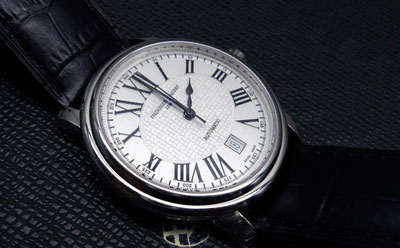
Watches – A functional piece of jewelry, watches are as safe as wedding rings and acceptable to wear in all circumstances except black tie events (although this is an old rule followed by few). In general the simpler the watch, the dressier it is. A plain black leather strap and simple silver timepiece with Arabic or Roman numerals is versatile and classic. Metal watches are fine for suits and sport jackets, while cloth bands and plastic watches should be reserved for casual wear.
Blazer Buttons – When a man buys a blazer it normally comes with simple brass buttons. He then has the option to upgrade them to gold or silver buttons. Horn and mother of pearl are options here as well, but the key is the blazer jacket is clearly distinguished by the ornamentation of the buttons.
Companies such as Ben Silver have built a strong reputation thanks to their wide selection of quality blazer buttons.
 Cufflinks & shirt studs – Cufflinks and shirt studs are functional jewelry pieces that hold the cuffs and front of a dress shirt in place, normally where buttons would have been. Shirt studs are most commonly associated with black tie attire, while cufflinks only require French or double cuffs. Metallic cufflinks made from precious metals in simple designs are the most formal, while any cufflink using a novelty design is more for fun around the office. Silk knots are a simple alternative to metals, and are a favorite with younger men.
Cufflinks & shirt studs – Cufflinks and shirt studs are functional jewelry pieces that hold the cuffs and front of a dress shirt in place, normally where buttons would have been. Shirt studs are most commonly associated with black tie attire, while cufflinks only require French or double cuffs. Metallic cufflinks made from precious metals in simple designs are the most formal, while any cufflink using a novelty design is more for fun around the office. Silk knots are a simple alternative to metals, and are a favorite with younger men.
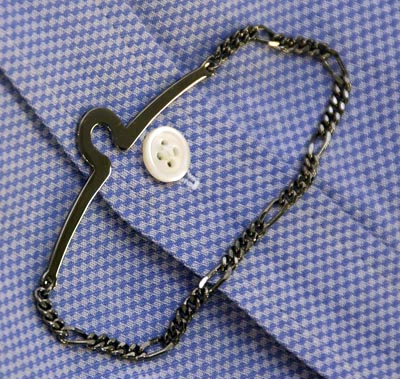
Tie accents – a tie accent serves the practical purpose of keeping your tie in place. This is commonly accomplished in three ways: with a tie pin, a tie bar, or a tie chain. Tie bars are simple strips of gold, silver, or other metal that clip onto the tie horizontally and hold it in place using the shirt as the anchor. Tie chains serve the same purpose as the tie clip but remain unseen, while the tie tack accent is best avoided as it sticks a pin through the tie.
Rings – Rings come in a wide variety of forms: class rings, fraternal rings, championship rings, and decorative rings. As mentioned previously, wedding rings are always acceptable, but other rings should be worn with more caution in the US. Class and fraternal rings are in most cases acceptable, while championship rings are best left for celebrations with old teammates or fights in a back alley. I have many European friends that wear decorative rings; within their ethnic circles in cities like Chicago and New York this is normal.
How many rings can a man wear? My answer is as many as he can confidently pull off. For most of us this is one or two rings–our wedding ring and perhaps a university or fraternal ring. We’ve been raised in a society that frowns on showing off success and wealth in this manner. But there are many men–especially travelers and immigrants–who can confidently wear 3 to 5 rings and not come off as a sleazy used car salesmen.
Lapel pins – They can be ornamental, collectable, or reveal a group affiliation. Lapel pins have been around for half a century, although the recent headlines would make you think they originated from American politicians looking to display their patriotism. Their history actually lies with the USSR and China where portraits of communist leaders were worn to display loyalty. Nowadays pin designs come in all shapes, colors, and meanings.
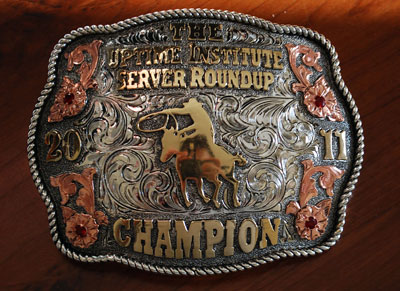
Belt Buckles – In the American West, trophy belt buckles have been around since the 1920s, handed out to rodeo and other contest winners. Not practical for normal work wear (although some wear them when dressing up), they became more common in the 1950s as Hollywood influenced their demand and acceptance. The rules on wearing a western buckle are this: if it’s a prize buckle, you or an ancestor should have won it. Otherwise leave them on the shelf. As for western buckles in general–wear them if they fit your personality and meet your needs.
Bracelets – Decorative, functional, cause-related, and medical alert. Men of royalty have worn ornamental bracelets for thousands of years, but more common today are cause-related bracelets such as Livestrong, functional ones such as parachute cord bracelets, or medical alert bracelets with a man’s vitals in case he loses consciousness.
I personally feel a man should be very careful with decorative bracelets; cause bracelets are another story. Despite their recent overuse, I think if a man is a true advocate of the cause, they are great conversation starters that can lead to greater awareness. As for survival bracelets–well, I have yet to hear a true story of a man surviving on account of his paracord bracelet. But feel free to enlighten me in the comments.

Necklaces – Decorative, functional, medical, or religious. As a military man I wore my dog tags for 6 years–never really got used to it though as I’m not a necklace wearer. I know other men who love their gold chains, and wear them 24/7 even on the beach. Necklaces are an easy piece of jewelry to wear because they can be hidden under the clothing. Since only a sliver can be seen by others, they create a feeling of curiosity and can thus be a great conversation starter. As for length and number to be worn–less is more. Two is about the most I recommend. For length, at least six to eight inches above your navel is a good standard.
Earrings – The most accepted piercing for men. They have gained wider appeal over the last 30 years and nowadays do not garner much interest in large cities, although in smaller communities and conservative businesses they are still frowned upon by many. Ear piercings’ main advantage is that the earring can be easily removed if required for work.
Other Piercings – Nose, brow, and other. Facial piercing and the jewelry associated with it have not reached mainstream acceptance. There are cities (and cultures) where this type of ornamentation is normal; however, it is perceived by many in the US as a sign of rebellion.
Ethnic jewelry – As varied as the people of this planet, the key with wearing ethnic pieces is to remember your surroundings. What works in northern Thailand won’t necessarily fly in Cedar Rapids, Iowa. However, tasteful pieces such as tribal bracelets can help you stand out from the masses and help tell the story of your family’s journey.
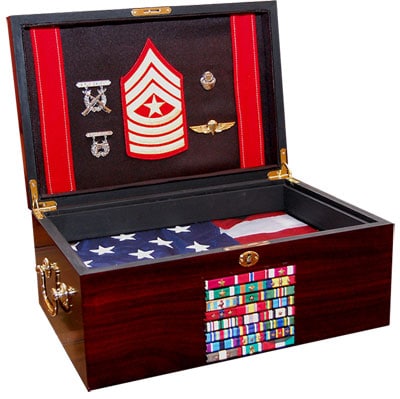
Military Jewelry – Warriors have adorned their uniforms with pieces of medal and ribbon for thousands of years. If this doesn’t dispel the myth that jewelry is feminine, I don’t know what will.
Religious Jewelry – Prayer beads, rosary beads, Japa mala, medallion necklaces, and scapulars. Wear them in accordance with your faith’s teachings. And be respectful of the importance others place on these items even if you are not of their religion.
Jewelry to Avoid – Grills, anklets, toe rings, belly piercings, engagement rings, armlets………no,no,no, never, no, and no.
_________________________________________
Written by Antonio Centeno
Founder, Real Men Real Style
Click Here To Grab My Free 47-Page Men’s Style eBook



